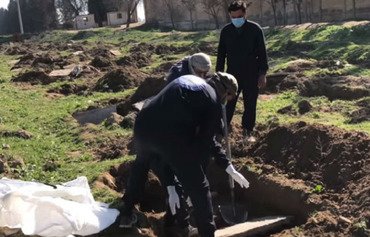News of the discovery of 72 mass graves in Iraq and Syria containing the remains of "Islamic State of Iraq and the Levant" (ISIL) victims lays bare the group's criminality and utter disregard for life, witnesses and observers say.
The grave sites, documented and mapped by the Associated Press in an August 30th report using exclusive interviews, photos and research, show the extent of ISIL's mass executions and reveal it has done little to hide its crimes, they said.
The report, the most comprehensive to date, estimates that the sites, 17 of which are in Syria and the rest of which are in Iraq, contain the remains of between 5,200 and 15,000 victims, executed either publicly or in secret.
It notes the strong possibility that the number of mass graves and victims will rise as more sites are uncovered in areas that remain under the group's control.
Speaking with Diyaruna last week, former al-Raqa Media Office activist Majed Hassoun said he is sure these numbers will rise as more sites are discovered.
"The announced numbers will not be close to the actual number of victims and graves," said Hassoun, who now lives in Turkey, noting that in Syria alone there are dozens of suspected mass grave sites where the group buried its victims.
Residents of al-Raqa city and its hinterland "know that the group dumps its victims into a deep gorge in the rocks known as al-Houta", he said.
The group itself released a video in 2014 showing its fighters hurling bodies into the crevasse, he added.
ISIL fighters transport the bodies of their victims to unknown locations, he said, noting there are suspicions that some areas on the outskirts of al-Raqa are being used as mass graves, as the group finds it increasingly difficult to travel to remote areas to dispose of the corpses.
Disregard for human life
The discovery of mass graves containing ISIL’s victims is "further evidence of the brutality of the terrorist group, which is the bloodiest in history", said Sheikh Moaz Abdul Karim, a former preacher at al-Omar mosque in Aleppo city who now resides in Cairo.
The group has violated sharia and the teachings of Islam by deeming it permissible for its fighters to shed blood in this manner, he told Diyaruna.
"ISIL is basically following a path that is contrary to Islam, which prohibits killing, bloodshed and terrorism for the sake of pledging allegiance and loyalty," Abdul Karim said.
The discovery of these mass graves is a "testament to the need to eradicate ISIL as soon as possible to rid humanity, and not only the Arab region, of its brutality and terrorism", he added.
According to the Associated Press report, Abdul Karim said, the bodies in the graves had been buried close to the surface.
"In other words, the group’s elements did not bother to at least dig deep enough graves, which indicates obvious disdain for the human soul, both in killing them and how [the corpse] is disposed of," he said.
This lack of respect for the dead has been common practice for the group since its inception, he added.
Further, he said, ISIL has used footage and reports of these executions as a means to promote itself, display its dominance and recruit new fighters.
A survivor's story
In November 2013, ISIL fighters detained Syrian journalist Jihad al-Rahim on the outskirts of al-Raqa city, and transported him, along with several others, to a prison camp where dozens of detainees were being held, he told Diyaruna.
"The car traveled for less than 10 minutes and we arrived at ISIL’s headquarters," he said.
They were ordered out of the vehicle and told to stand against a wall. After about 10 minutes, he said, a man speaking in the Iraqi dialect began questioning them about their names and occupations in "an aggressive and threatening tone".
"When he got to me, I told him my name was Jihad al-Rahim, that I worked as a journalist, and that I was heading to Turkey," al-Rahim said.
"He responded in an arrogant tone: A journalist going to Turkey? We will send you to al-Houta," he said.
Al-Rahim was released after 12 days and fled to Turkey, eventually making his way to Germany in 2015, where he now lives with his family.
Prosecuting the perpetrators
"The discovery of graves in both Syria and Iraq is conclusive evidence of the extreme hostility the group displays against anyone who opposes it or disobeys its orders," said Iraqi businessman Omar al-Jaafi, who currently resides in Cairo.
A large number of the corpses found in the mass graves were those of women and children, he told Diyaruna, and this is indicative of the group’s criminal inclinations and its willingness to do anything to establish its dominance.
Cairo University criminal law professor Wael al-Sharimi stressed the need for international assistance in conducting forensic testing on the exhumed corpses and skeletons in order to determine their identity.
A dossier must be established for every mass grave that is found to document and investigate the circumstances surrounding each one, he told Diyaruna, with the aim of prosecuting the perpetrators in the international courts.
"The mass graves are no longer an issue that concerns only Iraq or Syria, but are rather an issue that affects global security in general," he said.
"The perpetrators must be held accountable by international [courts] in order to rid the world of the criminals who ordered and carried out these crimes," he added.

![The 'Islamic State of Iraq and the Levant' has produced video footage showing its fighters throwing the bodies of its victims into al-Houta gorge in al-Raqa province. [Photo courtesy of Mohammed al-Abdullah]](/cnmi_di/images/2016/09/12/6165-Syria-houta-gorge-600_384.jpg)






